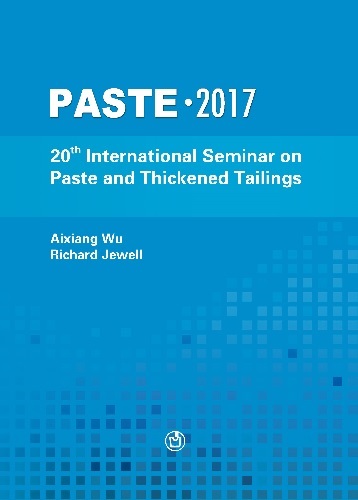Performance optimization of paste thickening

|
Authors: Kosonen, M; Kauvosaari, S; Gao, S; Henriksson, B |
DOI https://doi.org/10.36487/ACG_rep/1752_02_Kosonen
Cite As:
Kosonen, M, Kauvosaari, S, Gao, S & Henriksson, B 2017, 'Performance optimization of paste thickening', in A Wu & R Jewell (eds), Paste 2017: Proceedings of the 20th International Seminar on Paste and Thickened Tailings, University of Science and Technology Beijing, Beijing, pp. 13-22, https://doi.org/10.36487/ACG_rep/1752_02_Kosonen
Abstract:
Traditionally, thickener controls are implemented as single loop controllers in plant control systems. Based on our experiences from numerous thickener installations, this approach has several drawbacks, leading easily to poor process control and sub-optimal process performance. Especially challenging applications are paste thickeners, where the requirement is to achieve consistently high underflow density and high system availability without suffering process upsets and mechanical failures. The main reason for the poor performance of the traditional, single loop Proportional Integral (PI) controllers is their inability to handle the slow response dynamics and cross action between controlled variables. This makes tuning of the PI-loops challenging, and compromises have to be made between system robustness and the desired speed of response. In many cases, these controllers are run either totally or partially in manual mode, and operator intervention is needed to maintain process stability and the desired operation point in varying running situations. This paper discusses the optimizing control solution for paste thickeners. Initially, the instrumentation needed is briefly discussed. After this, an optimizing control solution based on multivariable model predictive control (MPC) is introduced, and the results from applying this control strategy to a production scale concentrate thickener are presented. Finally, a simulated example shows how the same control strategy improves the performance of paste thickener when compared to traditional control strategies. It is shown that by using an advanced, model based control strategy, the thickener can consistently run with higher and more stable underflow density, so that the required level of overflow clarity is also obtained.
References:
Kosonen, M. 2004, ‘Modeling and online control of paper machine wire retention’, Dissertation, Tampere University of Technology, Tampere, Finland.
Maciejowski, J.M. 2002, ‘Predictive control with constraints’, Prentice Hall, London.
Parker, B., Rivett, T., Backeberg, T., McIntosh, A., El-Masry, S. and Heath, A. 2016, ‘Debottlenecking of thickeners in a changing environment’, Outotec white paper.
Remes, A., Aaltonen, J., Koivo, H. 2009, ‘Soft-sensor estimation of an apatite thickener operation at the Siilinjärvi concentrator’, Pre-prints of IFAC Workshop on Automation in Mining, Minerals and Metal Industry, Nina del Mar, Chile
Remes, A., Vesa, L. 2014, ‘Thickener modeling from laboratory test work to plant scale dynamics simulation’, IMPC 2014, Santiago, Chile
© Copyright 2025, Australian Centre for Geomechanics (ACG), The University of Western Australia. All rights reserved.
View copyright/legal information
Please direct any queries or error reports to repository-acg@uwa.edu.au
View copyright/legal information
Please direct any queries or error reports to repository-acg@uwa.edu.au